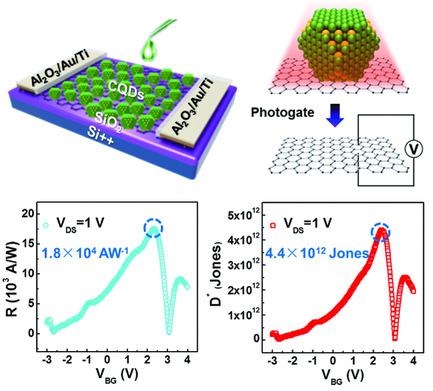当前位置:
X-MOL 学术
›
Adv. Opt. Mater.
›
论文详情
Our official English website, www.x-mol.net, welcomes your
feedback! (Note: you will need to create a separate account there.)
Ambipolar Graphene–Quantum Dot Phototransistors with CMOS Compatibility
Advanced Optical Materials ( IF 8.0 ) Pub Date : 2018-10-04 , DOI: 10.1002/adom.201800985 Li Zheng 1 , Wenjia Zhou 2 , Zhijun Ning 2 , Gang Wang 3 , Xinhong Cheng 1 , Weida Hu 4 , Wen Zhou 1 , Zhiduo Liu 5 , Siwei Yang 1 , Kaimin Xu 2 , Man Luo 4 , Yuehui Yu 1
Advanced Optical Materials ( IF 8.0 ) Pub Date : 2018-10-04 , DOI: 10.1002/adom.201800985 Li Zheng 1 , Wenjia Zhou 2 , Zhijun Ning 2 , Gang Wang 3 , Xinhong Cheng 1 , Weida Hu 4 , Wen Zhou 1 , Zhiduo Liu 5 , Siwei Yang 1 , Kaimin Xu 2 , Man Luo 4 , Yuehui Yu 1
Affiliation

|
The hybridization of 2D materials and colloidal quantum dots (CQDs) has been demonstrated to be an ideal platform for infrared photodetectors due to the high mobility of 2D materials and the excellent light harvesting capability of CQDs. However, the realization of ambipolar, broadband, and room‐temperature graphene–quantum dot phototransistors with complementary metal–oxide–semiconductor (CMOS) compatibility remains challenging. Here N, S codecorated graphene is deposited with PbS CQDs to fabricate a hybrid phototransistor on a silicon dioxide/silicon gate. The resulting device demonstrates a gate‐tuneable ambipolar feature with a low gate bias of less than 3.3 V at room temperature in ambient. Broadband spectra from visible to near‐infrared and to short wave infrared (SWIR) light can be detected with gain value of up to 105 and a fast response of 3 ms. Upon illumination by SWIR light at 1550 nm, the phototransistor exhibits an ultrahigh responsivity that is on the order of 104 AW−1 and a specific detectivity that is on the order of 1012 Jones with a low driving voltage of 1 V. This decorated hybrid architecture illustrates the potential of graphene and CQDs to be integrated with silicon integrated circuits and opens a new path toward ambipolar photodetector fabrication.
中文翻译:

具有CMOS兼容性的双极性石墨烯–量子点光电晶体管
二维材料和胶体量子点(CQD)的杂交已被证明是红外光电探测器的理想平台,这是因为二维材料的高迁移率和CQD的出色的光收集能力。然而,具有互补金属氧化物半导体(CMOS)兼容性的双极性,宽带和室温石墨烯量子点光电晶体管的实现仍然具有挑战性。在这里,N,S配位石墨烯与PbS CQD一起沉积,以在二氧化硅/硅栅极上制造混合光电晶体管。最终的器件展示了可在栅极调节的双极性特性,在室温下于环境温度下具有低于3.3 V的低栅极偏置。从可见光到近红外光再到短波红外(SWIR)光的宽带光谱可以检测到的增益值高达105和3毫秒的快速响应。在1550 nm的SWIR光照射下,光电晶体管表现出的超高响应度约为10 4 AW -1,比检测率约为10 12 Jones且驱动电压为1V。混合架构说明了石墨烯和CQD与硅集成电路集成的潜力,并为双极性光电探测器的制造开辟了一条新途径。
更新日期:2018-10-04
中文翻译:

具有CMOS兼容性的双极性石墨烯–量子点光电晶体管
二维材料和胶体量子点(CQD)的杂交已被证明是红外光电探测器的理想平台,这是因为二维材料的高迁移率和CQD的出色的光收集能力。然而,具有互补金属氧化物半导体(CMOS)兼容性的双极性,宽带和室温石墨烯量子点光电晶体管的实现仍然具有挑战性。在这里,N,S配位石墨烯与PbS CQD一起沉积,以在二氧化硅/硅栅极上制造混合光电晶体管。最终的器件展示了可在栅极调节的双极性特性,在室温下于环境温度下具有低于3.3 V的低栅极偏置。从可见光到近红外光再到短波红外(SWIR)光的宽带光谱可以检测到的增益值高达105和3毫秒的快速响应。在1550 nm的SWIR光照射下,光电晶体管表现出的超高响应度约为10 4 AW -1,比检测率约为10 12 Jones且驱动电压为1V。混合架构说明了石墨烯和CQD与硅集成电路集成的潜力,并为双极性光电探测器的制造开辟了一条新途径。











































 京公网安备 11010802027423号
京公网安备 11010802027423号